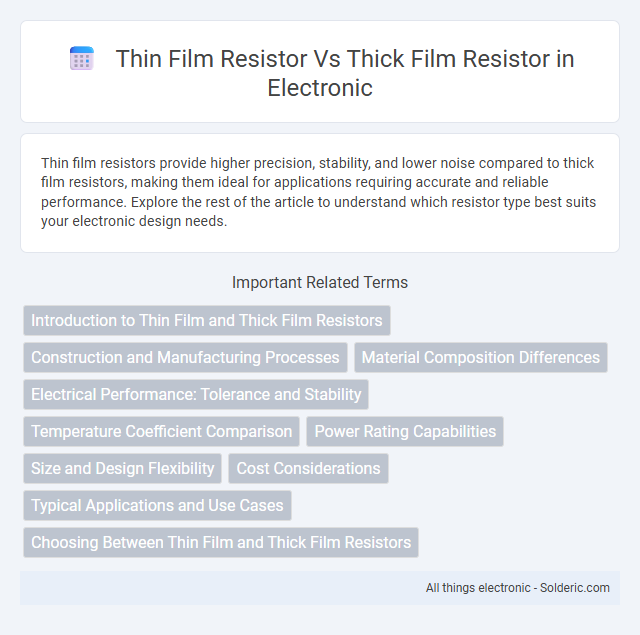Thin film resistors provide higher precision, stability, and lower noise compared to thick film resistors, making them ideal for applications requiring accurate and reliable performance. Explore the rest of the article to understand which resistor type best suits your electronic design needs.
Comparison Table
| Feature | Thin Film Resistor | Thick Film Resistor |
|---|---|---|
| Manufacturing Process | Deposited thin metal layers on insulating substrate | Screen-printed resistive paste on ceramic substrate |
| Resistance Range | 1O to 1MO | 10O to 10MO |
| Tolerance | +-0.1% to +-1% | +-1% to +-5% |
| Temperature Coefficient | 5 to 50 ppm/degC | 100 to 300 ppm/degC |
| Power Rating | 0.1W to 1W | 0.5W to 5W |
| Noise Level | Low noise | Higher noise |
| Stability | High long-term stability | Moderate stability |
| Cost | Higher cost | Lower cost |
| Applications | Precision circuits, automotive, aerospace | General purpose, power electronics |
Introduction to Thin Film and Thick Film Resistors
Thin film resistors are created by depositing a very thin layer of resistive material, typically metal or metal oxide, on an insulating substrate, resulting in high precision and stability with low noise characteristics. Thick film resistors involve a paste made of resistive material, usually metal oxides, that is applied and fired onto a ceramic base, offering cost-effective production with higher power dissipation but less precision. Both resistor types serve specific applications, with thin film preferred in high-frequency, high-accuracy circuits, and thick film favored for general-purpose and high-power uses.
Construction and Manufacturing Processes
Thin film resistors are created by depositing a very thin layer of resistive material, such as metal or metal oxide, onto an insulating substrate using techniques like sputtering or evaporation, resulting in precise thickness control and tight tolerance. Thick film resistors involve screen-printing a resistive paste composed of conductive and glass materials onto a ceramic base, followed by firing at high temperatures to fuse the materials, which provides durability but with higher tolerance variation. Understanding these construction and manufacturing differences helps you select the appropriate resistor type based on precision requirements and production cost.
Material Composition Differences
Thin film resistors use a thin layer of metal alloy deposited on an insulating substrate, offering precise and stable resistance values with low temperature coefficients. Thick film resistors consist of a mixture of conductive and glassy materials screen-printed onto a ceramic base, providing higher power ratings but with less accuracy compared to thin films. Your choice depends on the required precision, thermal stability, and application environment.
Electrical Performance: Tolerance and Stability
Thin film resistors offer superior electrical performance with tighter tolerance ranges typically around +-0.1% to +-1%, ensuring precise resistance values crucial for high-accuracy applications. Their stability over time and temperature is enhanced due to the uniform thin metal layer, resulting in lower temperature coefficients of resistance (TCR) often below 50 ppm/degC. In contrast, thick film resistors exhibit broader tolerance ranges of +-1% to +-5% and higher TCR values, making them less stable but cost-effective for general-purpose uses.
Temperature Coefficient Comparison
Thin film resistors exhibit a significantly lower temperature coefficient of resistance (TCR), typically around +-5 to +-25 ppm/degC, compared to thick film resistors which generally have a TCR ranging from +-100 to +-300 ppm/degC. This characteristic makes thin film resistors preferable in precision applications requiring stable resistance values across temperature variations. The enhanced thermal stability of thin film resistors results from their uniform metal alloy deposition, whereas thick film resistors rely on ceramic-metal composites with less consistent temperature response.
Power Rating Capabilities
Thin film resistors typically offer lower power rating capabilities, generally up to 0.25 watts, due to their thin and delicate metal layer structure, making them suitable for precision, low-power applications. Thick film resistors, constructed with a ceramic base and a more robust resistive paste, boast higher power ratings often exceeding 1 watt, allowing them to withstand greater thermal stress and dissipate more power reliably. This fundamental difference in power dissipation is crucial when selecting resistors for high-current or high-power circuit requirements.
Size and Design Flexibility
Thin film resistors offer superior size and design flexibility compared to thick film resistors due to their ability to be manufactured in much thinner layers, typically only a few nanometers thick, allowing for miniaturization in high-density circuit layouts. Their precise laser trimming process enables tight resistance tolerances and complex circuit designs within compact spaces, making them ideal for applications requiring small footprints and high accuracy. Your choice between thin and thick film resistors should consider the demands for circuit miniaturization and precision in your electronic design.
Cost Considerations
Thin film resistors generally have higher manufacturing costs due to their precise deposition techniques and materials, making them more suitable for high-performance applications where accuracy is critical. Thick film resistors offer a more cost-effective solution as their screen-printing process allows mass production with less expensive materials, ideal for bulk applications with moderate precision requirements. Choosing between thin film and thick film resistors depends on balancing cost constraints against desired electrical performance and stability.
Typical Applications and Use Cases
Thin film resistors offer high precision and stability, making them ideal for applications in medical devices, aerospace instrumentation, and high-frequency circuits where accuracy is critical. Thick film resistors are commonly used in automotive electronics, power supplies, and consumer appliances due to their durability and cost-effectiveness in handling higher power loads. Your choice depends on the required tolerance, power rating, and environmental conditions of the intended application.
Choosing Between Thin Film and Thick Film Resistors
Choosing between thin film and thick film resistors requires evaluating factors like precision, stability, and cost. Thin film resistors offer high accuracy, low noise, and excellent thermal stability, making them ideal for sensitive applications such as aerospace and medical devices. Thick film resistors provide cost-effective solutions with higher power ratings and sufficient performance for general-purpose electronics and consumer devices.
Thin film resistor vs thick film resistor Infographic

 solderic.com
solderic.com